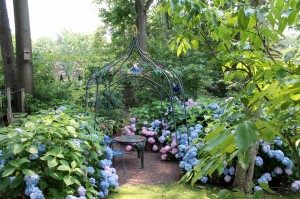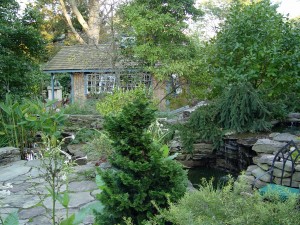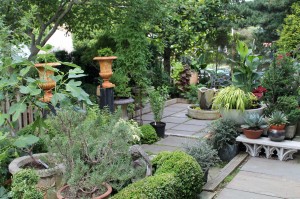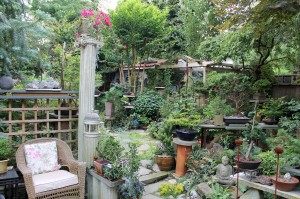Two Great Gardens
July 3rd, 2012
I’m still marveling at the layout of two of the finest home gardens I’ve ever seen – Jenny Rose Carey’s 4½-acre property near Ambler and Michael Colibraro’s small backyard getaway in suburban Willow Grove.
A full bus load of us got to see both in the same afternoon last week in our latest Lowee’s Garden Series trip, which also included a morning stop at Temple’s Ambler Arboretum, where Jenny is the director. (For the rest of this year’s tours, click here.)
What amazes me most about both places is the vision both of these gardeners had in turning otherwise blank or boring space into garden showpieces.
I’m sure neither of them see it that way. They’re just doing what they love and having great fun while at it.
I hate to use the overworked term “garden rooms,” but that’s really a good description here.
Jenny’s is by far the bigger of the two places, but Michael’s yard shows that even a small back yard sandwiched in a typical suburban-development street can be superbly interesting – and surprisingly serene.
Jenny started out about a dozen years ago with a mostly flat lot of grass.
Most people plant around the house, get some screening arborvitae in place along the property line and call it a day.
What’s unusual about Jenny is that she had no fear about digging up a majority of grass to create a series of theme gardens smack in the middle of the yard – somewhat Longwoodish in feel.
Each garden flows into a neighboring garden through the use of arbors, gates and paths – some of them bluestone, some gravel, some mulch, some grass. Assorted hedging, fences and tall shrubs, evergreens and even tall perennials are the “walls” that separate one room from the other.
This is a garden you explore as opposed to see. People loved wandering in and out of the different areas.
There’s a large “dry garden” of meadow perennials and rock-garden plants that Jenny hasn’t watered in 7 years, thanks to sharp soil and gravel mulch. A pergola-shaded stone patio with a table gives a place to sit in the middle of it. (For more on how Jenny grows a garden she never waters, click here.)
Exit the back of the dry garden and you run into one of the nicest potting sheds you’ll ever see. Jenny calls it the “Rose Cottage,” and it’s a garage-sized gardening playhouse where I could live (assuming it were air-conditioned).
Next to that is a raised stone patio outfitted with a large water garden and another sitting area.
That points you down into a rectangular herb garden that you enter through another arbor and eventually into another sitting area with a table and chairs.
Other areas lead you into a wooded fairy garden, a moss garden, a shade garden, a “Sunset Garden” of mostly dwarf conifers, a winter garden and a stumpery – a sculpture-like collection of stumps from trees past.
What really makes this even more special are the fun surprises Jenny’s got all throughout her gardens. Pay attention because you never know what you’re going to see.
Some things are obvious, like the VW-sized brass tea kettle pouring water into a big cup or the metal watering-can sculpture that’s a focal point in, where else, the dry garden.
Others are more subtle, like the dancing frog on a wall or the dinosaur footprints that lead to a nest of dinosaur “eggs” (actually a trio of oval rocks).
My favorite is the collection of “logheads,” which are faces and top-hatted heads made out of cut logs. The depressions made by pruned-out limbs make it look like the faces are saying, “Ooohh!”
Accessories like that don’t have to be expensive, but they’re great for making a garden fun and giving your own personality to the place.
Over at Michael’s place, his personality runs more toward bonsai, potted tropicals and unusual varieties of conifers and trees.
A French major by training, he got into landscaping after college (it paid bills). He soon found plants quelled his art yearnings, and he’s been in the design-and-build business since.
His yard is less than a quarter of an acre, but I couldn’t even begin to guess at the number of plants and species he’s packed in. Yet it doesn’t seem crowded because he keeps things pruned (a benefit of being a bonsai-ist).
You get the idea when you look at the small front yard, which has no grass and is now mostly a stone sitting area enclosed by shrubs with a decorative urn in the center.
To get into the back yard, you pass through a beautiful metal doorway that opens into a garden of pots and bonsai.
To the left is a patio with table — enclosed in painted lumber shelves decked out in bonsai and potted plants and looking much like an elegant dining room.
A curving path winds you into the small back yard and eventually to a covered sitting area in the back. Along the way you run into all sorts of nooks and crannies with specimen trees, shrubs, perennials, potted tropicals and bonsai everywhere you look.
His favorite plant that day was the Japanese hornbeam tree that was loaded with hops-like pods.
More than anything, this is a plant collector’s garden. Instead of belonging to a book club, Michael is in a group that plays “Stump the Chump” in which members try to acquire plants that no one else can even identify.
Cool gardeners, both Jenny and Michael. Very inspiring, too, for the rest of us.













